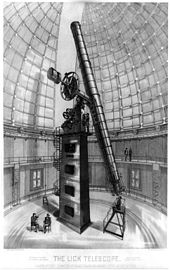 The James Lick telescope | |
| Named after | James Lick |
|---|---|
| Part of | Lick Observatory |
| Location(s) | Lick Observatory Main Building, Santa Clara County, California, Pacific States Region |
| Coordinates | 37°20′28″N 121°38′35″W / 37.34111°N 121.64306°W |
| Organization | University of California |
| Altitude | 4,200 ft (1,300 m) |
| First light | 3 January 1888 |
| Telescope style | optical telescope refracting telescope |
| Diameter | 36 in (0.91 m) |
| Length | 57 ft (17 m) |
| Mass | 25,000 lb (11,000 kg) |
| Focal length | 17.37 m (57 ft 0 in) |
| Mounting | equatorial mount |
| Enclosure | dome |
| Website | www |
| | |

The James Lick Telescope is a refracting telescope built in 1888. It has a lens, which is 91 centimetres (36 in) in diameter—a major achievement in its day. The instrument remains in operation and public viewing is allowed on a limited basis. Also called the "Great Lick Refractor" or simply "Lick Refractor", it was the largest refracting telescope in the world until 1897, and now ranks third,[not verified in body] after the 40-inch refractor at the Yerkes Observatory and the Swedish 1-m Solar Telescope. (The many larger telescopes in use today are reflecting telescopes, with a mirror rather than lens as the major optical component.) The telescope is located at the University of California's Lick Observatory atop Mount Hamilton at an elevation of 1,283 metres (4,209 ft) above sea level. The instrument is housed inside a dome that is powered by hydraulic systems that raise and lower the floor, rotate the dome and drive the clock mechanism to track the Earth's rotation. The original hydraulic arrangement still operates today, with the exception that the original wind-powered pumps that once filled the reservoirs have been replaced with electric pumps. James Lick is entombed below the floor of the observing room of the telescope.
Here are some excerpts from an 1894 book describing the telescope:[1]
The height of the marble floor of the main building above mean sea level is 4209 feet. On a closely connected peak half a mile to the east of the Observatory, and 50 feet higher, are the reservoirs from which water for household and photographic purposes is distributed. A spring about 350 feet below and one mile to the northeast of the Observatory supplies excellent water. Another peak seven-eighths of a mile to the east is the summit of Mount Hamilton; it is 180 feet higher than the Observatory, and supports the reservoirs supplying power for moving the dome, raising the movable floor, and winding the driving clock of the great telescope. This system receives its supply from the winter rains falling on the roofs; the water being pumped to the reservoirs on the higher peak by means of windmills.
The movable floor in the dome is the first of the kind to be constructed. It is 18 metres (60 ft) in diameter, and can be raised or lowered through a distance of 16+1⁄2 feet (5.0 m), its purpose being to bring the observer within convenient reach of the eye end of the telescope.
- ^ A Brief Account of the Lick Observatory of the University of California. The University Press, 1894.
